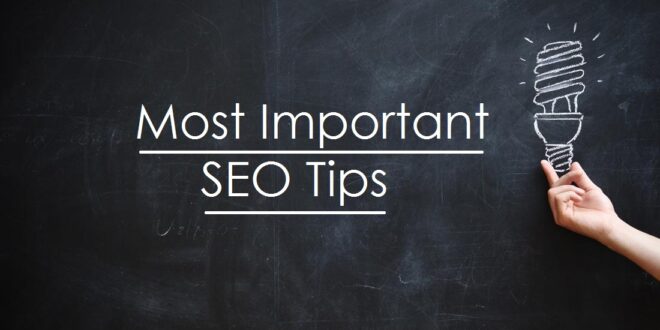Search engine optimization (SEO) is a lot like fitness. You can’t take a short-term approach and expect to see results. If you want to be on the first page of Google, you need to focus on consistently improving your SEO over time.
This can be a slow process, but it’s worth it—not only for your business’ bottom line, but also because we all know how frustrating it is when someone else beats us at something we’re good at! So let’s dive into some tips from SEO Agency Dubai that will help get your website ranked higher than its competitors’ websites:
Use Keywords in your URLs
The next thing you should do is make sure your URLs include keywords. When it comes to SEO, there are a few best practices for writing URLs:
- Don’t use too many keywords in one URL—this can be confusing and looks sloppy. You want the whole URL to read well, not like an overcrowded billboard or spamy email subject line.
- Don’t write a URL that’s not relevant to what’s on the page—it’s important that this link matches up with its destination perfectly, so avoid using overly generic words such as “click,” “here,” or “more.”
- Don’t include special characters in your URLs—these can cause problems when they’re copied and pasted into search engines.
Optimize Your Title Tag and Meta Description
The title of your page is what appears in the browser tab, so it’s important to get this right. A good rule of thumb is that the title should be short and descriptive of what the page contains. The Meta description is a short snippet about your website that appears below the title tag on Google results pages, so make sure you include some keywords within it as well (but don’t keyword stuff!).
- Keep an eye on broken links and redirects using Google Search Console or Screaming Frog SEO Spider
Get Deeper With Keyword Research
Once you have a better idea of the keywords your audience is interested in, it’s time to dig even deeper. Now you can find out what people are actually searching for by looking at search volume and competition scores (among other things).
Once you know what they’re searching for, it’s time to determine how much interest there is in each keyword term and how much competition exists to rank well for those terms. Those metrics will let you know if that particular keyword should be a priority or not.
For example, if someone searches for “SEO tips” and there are 100 other websites vying for their attention in search results pages (SERPs), then that term might not be worth focusing on because the competition will be too high and it may take years before your website ranks well enough to gain traffic from those searches.
Build Links the Right Way
When you build a link to your site, make sure it’s natural and relevant. Don’t just buy links. In fact, one of the biggest reasons Google downgrades websites is because they’ve purchased links—and if they catch you doing so, they can penalize your site by removing it from their index. Buying links also hurts the quality of search results since people will be less likely to click on a result that looks spammy or suspicious.
Finally, don’t build links through shady means such as comment spamming (commenting on unrelated blogs under different names) or buying links from companies that sell them in bulk—those are called “link farms” and Google considers them bad for users’ experience because they create low-quality content (more on low-quality content later).
Build Internal Links to Improve Navigation and SEO
Internal links are the links that you create on your own website. They’re important because they can help users navigate your site, but they also have a huge impact on SEO and the overall crawl rate of your website.
Internal links should be used to link to content that’s similar and relevant to other pieces of content on your site. That way, when someone searches for something related to one piece of content, Google knows that there’s more related content around it somewhere else on your site—and will prioritize crawling those additional pages.
One way we use internal links by creating blog posts with the same topic or theme as existing articles from our main blog page (for example: “What are some common mistakes made by startups?”). This helps us re-use existing topics but it also ensures that our new content takes advantage of internal linking opportunities so as not to overwhelm visitors with too many different ways of accessing old information!
Add More Than Text to Your Pages
It’s not just the content you publish that matters, but also how you present it. By adding images and videos to your pages (and by making sure they’re relevant to the topic), you help Google understand what your site is about and make it more engaging for readers.
Use social media buttons on your site so that users can share articles directly from your page—this will help drive traffic back to your website when other people click those links in their social feeds.
If you have an infographic that summarizes key points from one of your articles, include it on both pages so that search engines know exactly what they’re getting into before they come across them in their results. You can also use widgets like surveys or polls as another way to engage with readers while increasing SEO at the same time!
Make Your Content Linkable To Attract Links That Improve SEO Rankings
Linkable content is easier to share, and it has a higher chance of being share. It’s also more likely to be link to.
What Do You Need To Create Linkable Content?
- Quality: The best way to get links is by creating quality content that people want to read and share. That said, there are ways you can boost the reach of your piece beyond just its quality. For example, if you’re writing a blog post about SEO tips on Medium (a platform where people tend not only enjoy reading but also sharing interesting articles), including an embedded tweet in the bottom right corner of your article could help promote it on social media platforms like Twitter or Facebook—where people might not have time for lengthy reads but may find these micro-posts worth reading anyway.
- Relevance: Create relevant titles for each page on your site so that Google sees an article about “best practices” as relevant when someone searches for info about best practices.
- Contextualuality: Use keywords in an appropriate place within each page title; adjust images’ alt text so they contain relevant keywords too.
- Consistency: Use consistent branding across all platforms
Make Site Navigation Easy For Visitors and Googlebot
Make site navigation easy for visitors and Googlebot. Then, make sure that it’s obvious where users should go when they arrive at your website.
If you have a large site with a lot of pages, consider using a sitemap to help Googlebot find your site and all its content. A sitemap is an XML file that contains information about the pages on your website (for example, category pages or blog posts). You can use software programs like Google Webmaster Tools to automatically create the sitemap for you.
To make sure that visitors can find what they’re looking for on your site, use search boxes during their browsing experience — but only if they are relevant!
For example, if a user searches “how old is Barack Obama?” then an “Obama age calculator” would be very appropriate; however if someone were searching for “daily deals Omaha” then including an “Omaha daily deals” search box might not be practical because there’s nothing specific enough in this query to warrant its inclusion with other searches related specifically only within Omaha itself (such as restaurants).
Make sure you optimize your website design so that both Googlebots AND humans can easily navigate from page-to-page without getting confuse (or lost). As we mentioned above: don’t rely too much on search boxes alone!
Write Better Content by Researching What People Want
Writing great content is the most important part of SEO. By writing about what people are searching for, you’ll be more likely to rank higher in the search engines and get more traffic.
If you’re not sure what people want to read about, look at your competitors’ websites, or consult tools like Google Trends (https://www.google.com/trends/). You can see what’s popular among a specific audience—or all of Google—with just one click.
If you have an idea for a blog post but aren’t sure if it will be well received by readers, search Buzz Sumo (https://buzzsumo.com/) to see other articles similar to yours that have been published recently and received high engagement on social media platforms like Facebook and Twitter.
Create a Sitemap File to Help Search Engines Crawl and Index Your Website More Easily
Creating a sitemap file for your website is an effective way to get more traffic from search engines. Here’s how:
- Create a sitemap file. A sitemap file is simply a text document that tells Google about the pages on your site and where they are located.
- Make sure you include all of the pages on your site, including subpages and even archive pages (which can be important in helping Google spider through your site).
- Include links to the sitemap file in your website’s navigation so that it’s easy to find by both visitors and search engines alike.
- Make sure you keep this link fresh as well; if someone lands on a page that’s not link from the main navigation menu, Google may think its new content and add it into their index too soon!
Search engine optimization is a long-term strategy, but you don’t have to wait forever for results. If you follow these steps consistently over time and make adjustments where necessary, you can see improvement in your website’s ranking on Google search results pages. It’s all about knowing the specific steps and implementing them consistently over time in order to see results.
Conclusion
If you’re looking to get your business on the first page of Google and other search engines, then hire professional SEO Company Dubai. It can feel like an overwhelming task. There are so many different parts to SEO that it can be difficult to know where to begin when trying to implement changes on your website. We hope these tips help guide you in the right direction!
 HammBurg Be informed with latest news, reviews, entertainment, lifestyle tips, and much more.
HammBurg Be informed with latest news, reviews, entertainment, lifestyle tips, and much more.




